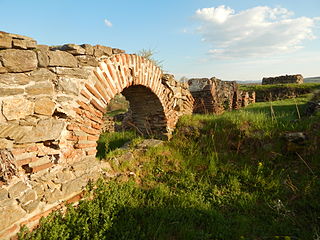
Praeses is a Latin word meaning "placed before" or "at the head". In antiquity, notably under the Roman Dominate, it was used to refer to Roman governors; it continues to see some use for various modern positions.
Leontopolis was an ancient Egyptian city located in the Nile Delta, Lower Egypt. It served as a provincial capital and Metropolitan Archbishopric. The archaeological site and settlement are known today as Kafr Al Muqdam.

Byzacena was a Late Roman province in the central part of Roman North Africa, which is now roughly Tunisia, split off from Africa Proconsularis.

The Thebaid or Thebais was a region in ancient Egypt, comprising the 13 southernmost nomes of Upper Egypt, from Abydos to Aswan.
Paralus was a historical settlement located at one of the seven mouths of the Nile, Egypt known as Paralus or Sebennys. During Byzantine times it was located in the province of Ægyptus Secunda. The place, mentioned in the Notitia Episcopatuum, has been abandoned and is now covered with the waters of Lake Burullus.
Consularis is a Latin adjective indicating something pertaining to the position or rank of consul. In Ancient Rome it was also used as a noun to designate those senators who had held the office of consul or attained consular rank as a special honour. In Late Antiquity, the title became also a gubernatorial rank for provincial governors.
Thmuis was a city in Lower Egypt, located on the canal east of the Nile, between its Tanitic and Mendesian branches. Its ruins are near the modern city of Timayy al-Imdid.

Arcadia or Arcadia Aegypti was a Late Roman province in northern Egypt. It was named for one of the reigning Augusti of the Roman Empire, Arcadius of the Theodosian dynasty when it was created in the late 4th century. Its capital was Oxyrhynchus and its territory encompassed the Arsinoite nome and the "Heptanomia" region.
Berissa, also spelled Berisa, Verisa, or Verissa, was a city in the late Roman province of Pontus Polemoniacus, in Asia Minor, which Kiepert and W. M. Ramsay have identified with the modern village of Baulus, 25 kilometres south-west of Tokat.

Babylon Fortress is an Ancient Roman fortress, built around 30 BC with the arrival of emperor Augustus in Egypt, on the eastern bank of the Nile Delta, located in the area known today as Coptic Cairo. It is situated in the former area of the Heliopolite Nome, upon the east bank of the Nile, at latitude 30°N, near the commencement of the Pharaonic Canal, from the Nile to the Red Sea.

The Diocese of Egypt was a diocese of the later Roman Empire, incorporating the provinces of Egypt and Cyrenaica. Its capital was at Alexandria, and its governor had the unique title of praefectus augustalis instead of the ordinary vicarius. The diocese was initially part of the Diocese of the East, but in ca. 380, it became a separate entity, which lasted until its territories were overrun by the Muslim conquest of Egypt in the 640s.
Casius or Casium was a residential episcopal see in the Roman province of Augustamnica Prima in Lower Egypt, and is now a titular see of the Catholic Church.
Hauara was an ancient episcopal see in Palestina Tertia, a suffragan of Petra.
Hephæstus was a town in Roman Egypt, in the province of Augustamnica Prima, the eastern part of the Nile Delta.
Rhesaina (Rhesaena) or Resina (Ῥέσινα) was a city in the late Roman province of Mesopotamia Secunda and a bishopric that was a suffragan of Dara.

Archbishopric of Justiniana Prima was an Eastern Christian autonomous Archbishopric with see in the city of Justiniana Prima and jurisdiction over the Late Roman Diocese of Dacia in central parts of the Southeastern Europe.

Marmarica in ancient geography was a littoral area in Ancient Libya, located between Cyrenaica and Aegyptus. It corresponds to what is now the Libya and Egypt frontier, including the towns of Bomba, Timimi, Tobruk, Acroma, Bardiya, As-Salum, and Sidi Barrani. The territory stretched to the far south, encompassing the Siwa Oasis, which at the time was known for its sanctuary to the deity Amun. The eastern part of Marmarica, by some geographers considered a separate district between Marmarica and Aegyptus, was known as Libycus Nomus. In late antiquity, Marmarica was also known as Libya Inferior, while Cyrenaica was known as Libya Superior.
Gera(s) was an ancient city and former bishopric in Roman Egypt and remains a Latin Catholic titular see.






